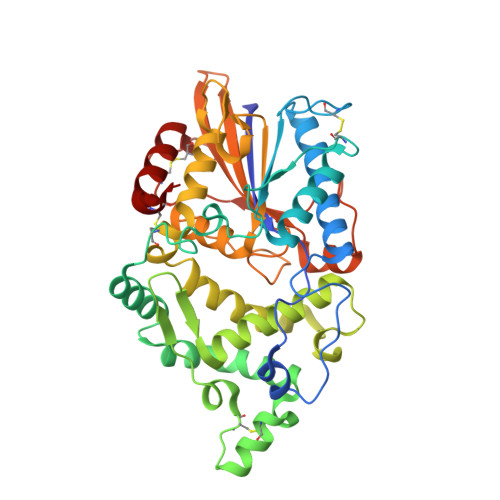Insights to the Structural Basis for the Stereospecificity of the Escherichia coli Phytase, AppA.
Acquistapace, I.M., Thompson, E.J., Kuhn, I., Bedford, M.R., Brearley, C.A., Hemmings, A.M.(2022) Int J Mol Sci 23
- PubMed: 35683026
- DOI: https://doi.org/10.3390/ijms23116346
- Primary Citation of Related Structures:
7Z1J, 7Z2S, 7Z2T, 7Z2W, 7Z2Y, 7Z32, 7Z3V - PubMed Abstract:
AppA, the Escherichia coli periplasmic phytase of clade 2 of the histidine phosphatase (HP2) family, has been well-characterized and successfully engineered for use as an animal feed supplement. AppA is a 1D-6-phytase and highly stereospecific but transiently accumulates 1D- myo -Ins(2,3,4,5)P 4 and other lower phosphorylated intermediates. If this bottleneck in liberation of orthophosphate is to be obviated through protein engineering, an explanation of its rather rigid preference for the initial site and subsequent cleavage of phytic acid is required. To help explain this behaviour, the role of the catalytic proton donor residue in determining AppA stereospecificity was investigated. Four variants were generated by site-directed mutagenesis of the active site HDT amino acid sequence motif containing the catalytic proton donor, D304. The identity and position of the prospective proton donor residue was found to strongly influence stereospecificity. While the wild-type enzyme has a strong preference for 1D-6-phytase activity, a marked reduction in stereospecificity was observed for a D304E variant, while a proton donor-less mutant (D304A) displayed exclusive 1D-1/3-phytase activity. High-resolution X-ray crystal structures of complexes of the mutants with a non-hydrolysable substrate analogue inhibitor point to a crucial role played by D304 in stereospecificity by influencing the size and polarity of specificity pockets A and B. Taken together, these results provide the first evidence for the involvement of the proton donor residue in determining the stereospecificity of HP2 phytases and prepares the ground for structure-informed engineering studies targeting the production of animal feed enzymes capable of the efficient and complete dephosphorylation of dietary phytic acid.
Organizational Affiliation:
School of Biological Sciences, University of East Anglia, Norwich Research Park, Norwich NR4 7TJ, UK.
















